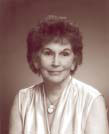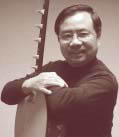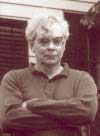Home | Programs | Individual Creativity | Ohio Heritage Fellowships | 2004 Heritage Fellowships
2004 Ohio Heritage Fellowship Recipients
Material Culture
 MARY BORKOWSKI was born in southeastern Ohio in 1916. She made her first quilt
in 1930 and has been quilting ever since. Some 80 quilts later, she is
nationally recognized as a true folk artist whose medium is needle and
thread. A Dayton resident since the 1930s, Borkowski is renowned for inventive
original designs-she's sold quilt patterns to McCall's and other magazines-and
peerless technique. Borkowski's quilts, which often commemorated historical
events or personalities, won grand prizes at the Ohio State Fair in 1952
and 1955. In the late 1950s, she set out to make the "perfect quilt."
The result was The Pride of Ohio, celebrating John Glenn's orbit
of the earth, which took top honors at the Ohio State Fair in 1962. Like
the best folk artists, Borkowski has both borrowed from tradition and
added her own innovations. Her singular contribution to traditional fiber
arts is the body of 110 "thread paintings" she's done since
1965. These works, an outgrowth of the narrative aspect of her quilts,
are done on silk, felt or velvet backgrounds and use silk thread and yarn.
The subject matter is generally drawn from events in Borkowski's life,
though what she calls her "string pictures" can also be surreal
and strange. The effect resembles embroidery, but with more depth and
texture. Borkowski's quilts and "thread paintings" are in several
major collections and museums, including the Smithsonian Institution,
the Museum of American Folk Art and the Dayton Art Institute.
MARY BORKOWSKI was born in southeastern Ohio in 1916. She made her first quilt
in 1930 and has been quilting ever since. Some 80 quilts later, she is
nationally recognized as a true folk artist whose medium is needle and
thread. A Dayton resident since the 1930s, Borkowski is renowned for inventive
original designs-she's sold quilt patterns to McCall's and other magazines-and
peerless technique. Borkowski's quilts, which often commemorated historical
events or personalities, won grand prizes at the Ohio State Fair in 1952
and 1955. In the late 1950s, she set out to make the "perfect quilt."
The result was The Pride of Ohio, celebrating John Glenn's orbit
of the earth, which took top honors at the Ohio State Fair in 1962. Like
the best folk artists, Borkowski has both borrowed from tradition and
added her own innovations. Her singular contribution to traditional fiber
arts is the body of 110 "thread paintings" she's done since
1965. These works, an outgrowth of the narrative aspect of her quilts,
are done on silk, felt or velvet backgrounds and use silk thread and yarn.
The subject matter is generally drawn from events in Borkowski's life,
though what she calls her "string pictures" can also be surreal
and strange. The effect resembles embroidery, but with more depth and
texture. Borkowski's quilts and "thread paintings" are in several
major collections and museums, including the Smithsonian Institution,
the Museum of American Folk Art and the Dayton Art Institute.
Performing Arts
 One of the United States' most respected performers and scholars in the field
of traditional Vietnamese music, PHONG NGUYEN has traveled a long road
to his Ohio Heritage Fellowship. Born in 1946 in a village in the Mekong
River delta in southern Vietnam, Nguyen began playing both string and
percussion instruments at an early age and was playing at a professional
level by the age of 10. Educated at the University of Saigon and the Sorbonne
in Paris, where he earned a doctorate in ethnomusicology, Nguyen has lived
in the U.S. since the 1980s and is now an American citizen. Well-known
within Vietnamese communities from Ohio to California, Nguyen is a Renaissance
man within the traditional music world. As a performing musician, Nguyen
has appeared at festivals and universities throughout the U.S., Europe
and Asia and has recorded several albums, both as a soloist and with the
Phong Nguyen Ensemble. Nguyen is particularly known for his expertise
on the dan tranh (17-string zither) and the dan nguyet (two-string lute).
He's a prominent educator who has taught at UCLA, Kent State and the University
of Washington. A respected scholar, he's founded an academic journal,
done extensive fieldwork and collecting, contributed essays to The New
Grove Dictionary of Music and Musicians and Garland Encyclopedia of World
Music, and written or co-written numerous articles and books, including
From Rice Paddies and Temple Yards: Traditional Music of Vietnam. The
Cleveland Heights resident was previously honored for his contributions
with a National Heritage Fellowship in 1997.
One of the United States' most respected performers and scholars in the field
of traditional Vietnamese music, PHONG NGUYEN has traveled a long road
to his Ohio Heritage Fellowship. Born in 1946 in a village in the Mekong
River delta in southern Vietnam, Nguyen began playing both string and
percussion instruments at an early age and was playing at a professional
level by the age of 10. Educated at the University of Saigon and the Sorbonne
in Paris, where he earned a doctorate in ethnomusicology, Nguyen has lived
in the U.S. since the 1980s and is now an American citizen. Well-known
within Vietnamese communities from Ohio to California, Nguyen is a Renaissance
man within the traditional music world. As a performing musician, Nguyen
has appeared at festivals and universities throughout the U.S., Europe
and Asia and has recorded several albums, both as a soloist and with the
Phong Nguyen Ensemble. Nguyen is particularly known for his expertise
on the dan tranh (17-string zither) and the dan nguyet (two-string lute).
He's a prominent educator who has taught at UCLA, Kent State and the University
of Washington. A respected scholar, he's founded an academic journal,
done extensive fieldwork and collecting, contributed essays to The New
Grove Dictionary of Music and Musicians and Garland Encyclopedia of World
Music, and written or co-written numerous articles and books, including
From Rice Paddies and Temple Yards: Traditional Music of Vietnam. The
Cleveland Heights resident was previously honored for his contributions
with a National Heritage Fellowship in 1997.
Material Culture
 A native of West Virginia who now lives near Akron, DOUG UNGER has earned
international renown both as an instrument builder and a master of the
arts of decorative inlay and pearl engraving. Like many instrument builders,
Unger started out as a musician. He's self-taught as a builder, but is
now regarded as one of the best in the country at making ornate one-of-a-kind
mandolins and banjos that look and sound like priceless antiques. While
Unger's designs are based on instruments made between the 1890s and the
early 1920s, his mandolins and banjos display a level of craftsmanship,
ornamentation and artistry rarely equaled during that "golden age."
His instruments require expertise in a number of areas, including woodcarving,
design, acoustical engineering, draftsmanship, inlay and engraving. Unger
has displayed his creations at the National Folk Festival, the Kent State
Folk Festival and other festivals, and his instruments are in private
collections throughout the world. Unger is highly regarded for his inlay
and engraving work. He cuts the inlays from sheets of mother-of-pearl,
abalone or ocean snail. After they have been glued into place on a fingerboard
or peghead, Unger engraves the inlays with hand tools and then puts ink
into the cuts to add depth and contrast. Unger is arguably the finest
pearl engraver in this country and almost certainly one of the best in
the world. A painter and multimedia artist, Unger has been a professor
of fine art at Kent State University for more than 30 years.
A native of West Virginia who now lives near Akron, DOUG UNGER has earned
international renown both as an instrument builder and a master of the
arts of decorative inlay and pearl engraving. Like many instrument builders,
Unger started out as a musician. He's self-taught as a builder, but is
now regarded as one of the best in the country at making ornate one-of-a-kind
mandolins and banjos that look and sound like priceless antiques. While
Unger's designs are based on instruments made between the 1890s and the
early 1920s, his mandolins and banjos display a level of craftsmanship,
ornamentation and artistry rarely equaled during that "golden age."
His instruments require expertise in a number of areas, including woodcarving,
design, acoustical engineering, draftsmanship, inlay and engraving. Unger
has displayed his creations at the National Folk Festival, the Kent State
Folk Festival and other festivals, and his instruments are in private
collections throughout the world. Unger is highly regarded for his inlay
and engraving work. He cuts the inlays from sheets of mother-of-pearl,
abalone or ocean snail. After they have been glued into place on a fingerboard
or peghead, Unger engraves the inlays with hand tools and then puts ink
into the cuts to add depth and contrast. Unger is arguably the finest
pearl engraver in this country and almost certainly one of the best in
the world. A painter and multimedia artist, Unger has been a professor
of fine art at Kent State University for more than 30 years.
[top]